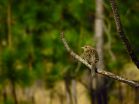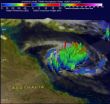Landscape-level habitat connectivity is key for species that depend on longleaf pine
2015-03-18
(Press-News.org) Preserving isolated patches of habitat isn't enough to save species such as Bachman's Sparrow (Peucaea aestivalis) that depend on longleaf pine; habitat connectivity at the landscape level is also crucial. That is the message of a new paper by Paul Taillie, M. Nils Peterson, and Christopher Moorman of North Carolina State University, published this week in The Condor: Ornithological Applications.
In the past, fire-dependent longleaf pine forests covered vast, unbroken areas of the southeastern U.S., and Bachman's Sparrows and other species adapted to live in this expansive habitat. Today, however, longleaf pines exist primarily in isolated patches surrounded by agriculture and urban development. To see whether small but well-managed patches of longleaf pine were enough to support healthy Bachman's Sparrow populations, Taillie and his colleagues surveyed Bachman's Sparrows in 111 habitat patches in spring 2011 and tested what factors best explained their distribution. They found that while the sparrows did prefer patches that had been burned recently, an even stronger predictor of the presence or absence of Bachman's Sparrows was how much of the land within three kilometers was devoted to longleaf pine--that is, how connected a patch was to a larger longleaf pine landscape.
"While we know a lot about the local habitat characteristics affecting Bachman's Sparrow habitat selection, we don't know much about the role of landscape-level factors," explains Taillie. "As a result of this research, we found that habitat selection actually appears to depend on a very broad range of scales, from 100 meters to several kilometers. Other studies have shown similar patterns for other species associated with longleaf pine, which suggests that connectivity may be important to the function of the greater ecosystem, and possibly other highly fragmented ecosystems as well. Thus, conservation management and planning efforts, such as prescribed burning, habitat restoration, and land acquisition, should also consider a broad range of scales to benefit the diverse assemblage of organisms that comprise this community."
"Taillie, Peterson and Moorman have made a significant contribution to the understanding of Bachman's sparrow's use of the landscape in eastern North Carolina," adds Jeff Marcus of the Nature Conservancy, a longleaf pine management expert who was not involved in the research. "As the broader conservation community strives to restore and enhance longleaf pine habitat across its range, it is important to understand not only the habitat characteristics but also the landscape characteristics that will lead to the most robust and resilient outcome for longleaf-associated species. The Bachman's sparrow is an excellent indicator species to help inform longleaf pine habitat needs because it is closely tied to well-managed longleaf habitat."
INFORMATION:
"The relative importance of multiscale factors in the distribution of Bachman's Sparrow and the implications for ecosystem conservation" is an open-access paper that can be viewed at http://www.aoucospubs.org/doi/full/10.1650/CONDOR-14-137.1.
About the journal: The Condor: Ornithological Applications is a peer-reviewed, international journal of ornithology. The journal began in 1899 as the journal of the Cooper Ornithological Club, a group of ornithologists in California that became the Cooper Ornithological Society.
[Attachments] See images for this press release:

ELSE PRESS RELEASES FROM THIS DATE:
2015-03-18
The TRMM satellite revealed that Tropical Cyclone Nathan had powerful thunderstorms known as "hot towers" near its center which are indicative of a strengthening storm.
Cyclone Nathan is located in the Coral Sea off Australia's Queensland coast. Nathan formed on March 10 near the Queensland coast triggering warnings there before moving east. Once out at sea, Nathan made a loop and headed back to Queensland.
On March 18, Nathan was nearing the Cape York Peninsula of Queensland. As a result warnings were in effect from Cape Melville to Innisfail, extending inland to Laura. ...
2015-03-18
Modern life, with its preponderance of inadequate exposure to natural light during the day and overexposure to artificial light at night, is not conducive to the body's natural sleep/wake cycle.
It's an emerging topic in health, one that UConn Health (University of Connecticut, Farmington, Conn.) cancer epidemiologist Richard Stevens has been studying for three decades.
"It's become clear that typical lighting is affecting our physiology," Stevens says. "But lighting can be improved. We're learning that better lighting can reduce these physiological effects. By that ...
2015-03-18
CORAL GABLES, Fla. (March 18, 2015) -- Come spring break, college students from all over the country travel to warmer climates for time off from school and to escape the cold weather. However, it's not all fun in the sun. At popular spring break destinations, fatalities from car crashes are significantly higher during the spring break weeks compared to other times of the year, according to a recent study published in the journal Economic Inquiry.
"We found that between the last week of February and the first week of April, a significantly greater number of traffic fatalities ...
2015-03-18
There's a carbon showdown brewing in the Arctic as Earth's climate changes. On one side, thawing permafrost could release enormous amounts of long-frozen carbon into the atmosphere. On the opposing side, as high-latitude regions warm, plants will grow more quickly, which means they'll take in more carbon from the atmosphere.
Whichever side wins will have a big impact on the carbon cycle and the planet's climate. If the balance tips in favor of permafrost-released carbon, climate change could accelerate. If the balance tips in favor of carbon-consuming plants, climate ...
2015-03-18
In 1996, a trio of scientists won the Nobel Prize for Chemistry for their discovery of Buckminsterfullerene - soccer-ball-shaped spheres of 60 joined carbon atoms that exhibit special physical properties.
Now, 20 years later, scientists have figured out how to turn them into Buckybombs.
These nanoscale explosives show potential for use in fighting cancer, with the hope that they could one day target and eliminate cancer at the cellular level - triggering tiny explosions that kill cancer cells without affecting surrounding tissue.
"Future applications would probably ...
2015-03-18
BLOOMINGTON, Ind. -- An Indiana University cognitive scientist and collaborators have found that posture is critical in the early stages of acquiring new knowledge.
The study, conducted by Linda Smith, a professor in the IU Bloomington College of Arts and Sciences' Department of Psychological and Brain Sciences, in collaboration with a roboticist from England and a developmental psychologist from the University of Wisconsin-Madison, offers a new approach to studying the way "objects of cognition," such as words or memories of physical objects, are tied to the position ...
2015-03-18
For generations, students have been taught the concept of "ecological succession" with examples from the plant world, such as the progression over time of plant species that establish and grow following a forest fire. Indeed, succession is arguably plant ecology's most enduring scientific contribution, and its origins with early 20th-century plant ecologists have been uncontested. Yet, this common narrative may actually be false. As posited in an article published in the March 2015 issue of The Quarterly Review of Biology, two decades before plant scientists explored the ...
2015-03-18
Tirat Carmel, Israel - March 19, 2015 - MeMed, Ltd., today announced publication of the results of a large multicenter prospective clinical study that validates the ability of its ImmunoXpert in-vitro diagnostic blood test to determine whether a patient has an acute bacterial or viral infection. The study enrolled more than 1,000 patients and is published in the March 18, 2015 online edition of PLOS ONE. Unlike most infectious disease diagnostics that rely on direct pathogen detection, MeMed's assay decodes the body's immune response to accurately characterize the cause ...
2015-03-18
The most extensive land-based study of the Amazon to date reveals it is losing its capacity to absorb carbon from the atmosphere. From a peak of two billion tonnes of carbon dioxide each year in the 1990s, the net uptake by the forest has halved and is now for the first time being overtaken by fossil fuel emissions in Latin America.
The results of this monumental 30-year survey of the South American rainforest, which involved an international team of almost 100 researchers and was led by the University of Leeds, are published today in the journal Nature.
Over recent ...
2015-03-18
Messenger RNAs (mRNA) are linear molecules that contain instructions for producing the proteins that keep living cells functioning. A new study by UCL researchers has shown how the three-dimensional structures of mRNAs determine their stability and efficiency inside cells. This new knowledge could help to explain how seemingly minor mutations that alter mRNA structure might cause things to go wrong in neurodegenerative diseases like Alzheimer's.
mRNAs carry genetic information from DNA to be translated into proteins. They are generated as long chains of molecules, but ...
LAST 30 PRESS RELEASES:
[Press-News.org] Landscape-level habitat connectivity is key for species that depend on longleaf pine




